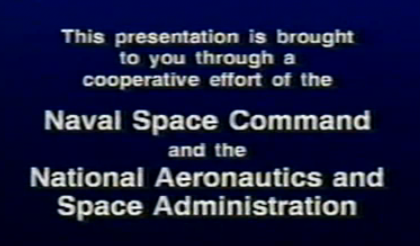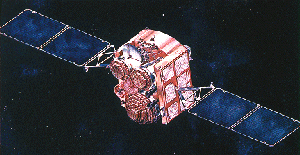|
.. |
||
|
The Navy's Secrets |
||
|
..
|
||
|
.. October 05, 2008
National Aeronautics and Space Administration Space
Flight:
This video details planetary motion or orbital mechanics. It explains Kepler's and Newton's Laws plus terminology including perigee, apogee, eccentricity, orbital inclination, launch window, etc.
|
||
|
Naval Space Command History The naval services' growing dependence on space prompted the Secretary of the Navy to establish a new command that would consolidate space activities and organizations that operate and maintain naval space systems. This new organization - the Naval Space Command - was commissioned on October 1, 1983. It was a decisive move to bring together several activities under a single command to strengthen operational control, provide a central focal point for naval space matters, and more effectively guide future operational uses of space. Mission Naval Space Command uses the medium of space and its
potential to provide essential information and capabilities to ashore and
afloat naval forces by:
Advocating naval warfighting requirements in the joint arena; and Advising, supporting, and assisting naval services through training and by developing space plans, programs, budgets, policies, concepts and doctrine. As an Echelon 2 command,Naval Space Command reports directly to the Director of Space and Electronic Warfare (N-6) and the Director of Naval Warfare (N-7). Our tasking to support Marine Corps forces comes through the staff of the Commandant of the Marine Corps. In addition, Fleet commanders-in-chief are authorized a direct line of communication with the command for requesting specific operational support. Naval Space Command also serves as the naval service component of the United States Space Command (USSPACECOM), established in 1985. Component responsibilities include operating assigned space systems to provide surveillance and warning, as well as providing spacecraft telemetry and on-orbit engineering support. In addition, Naval Space Command provides facilities for and staffs a command center 24 hours a day to serve as the Alternate Space Control Center for U.S. Space Command's primary center located at Cheyenne Mountain Air Station, Colorado. The Alternate Space Control Center missions include operational direction of the entire global Space Surveillance Network for Commander-in-Chief Space (CINCSPACE). The Center also detects, tracks, identifies, and catalogs all manmade objects in space and provides ephemerides on these objects to about 1,000 customers; and monitors the space environment and informs owners and operators of U.S. and allied space systems of potential threat to their assets by continuous liaison with the systems' operations centers. Finally, Naval Space Command provides administrative oversight for two Echelon 3 operational Navy activities: the Naval Satellite Operations Center and the Fleet Surveillance Support Command. Force Enhancement The heartbeat of Naval Space Command revolves around providing space support to day-to-day operations of the Fleet and Fleet Marine Forces worldwide, whether for routine deployments, exercises, or actions in response to a crisis situation. This space support to terrestrial forces can be categorized across a broad spectrum of activities that encompass communications, surveillance and indication and warning, intelligence, navigation, and remote sensing. Communications Naval Space Command is the system operational manager for Navy space-based communications systems, including the Fleet Satellite Communications System, Leased Satellite, and UHF Follow-On. Fleet Satellite provides worldwide ultra-high-frequency communications between naval aircraft, ships, submarines, ground stations, the U.S. Strategic Command, and national command authorities. The Fleet Satellite system, first operational in 1978, features spacecraft placed geostationary orbits around the equator. A satellite in this type of orbit matches the Earth's rotation in order to remain in roughly the same position over a specific area of the globe. A minimum of four satellites spaced equidistant around the globe provides worldwide coverage. Leased Satellite spacecraft, which also provides Ultra-High Frequency communications, were first launched in 1984 to augment the Fleet Satellite system. This Ultra-High Frequency constellation also features three satellites deployed in roughly the same positions as the Fleet Satellite spacecraft. To further enhance satellite communications capabilities for the future, Naval Space Command manages a joint-service project that has placed extremely-high-frequency communications test modules into orbit. Carried into space aboard Fleet Satellite spacecraft in 1987 and 1989, these experimental Fleet Satellite Extremely-High Frequency Packages are providing our naval forces with limited operational capability at Extremely-High Frequency and are enabling them to test new Extremely-High Frequency terminals being developed for a future military satellite system intended to provide a more survivable, jam-resistant communications capability. Naval Space Command also manages a new generation of Ultra-High Frequency communications satellites now being launched to replace Fleet Satellite and Leased Satellite systems, which are nearing the end of their operational lives. The Ultra-High Frequency Follow-On spacecraft are designed for a 14-year lifetime and will be compatible with ground-based and sea-based communications terminals already in service. The new satellites will use the same frequency spectrum as the current constellation of Ultra-High Frequency satellites, but will have additional transmitters to provide an increase in communications capacity. Midway through the program, Ultra-High Frequency Follow-On incorporates an Extremely-High Frequency communications payload. The Extremely-High Frequency package will provide enhanced anti-jam telemetry, command, broadcast, and Fleet interconnectivity communications. This payload will be on all subsequent Ultra-High Frequency Follow-On satellites. Each spacecraft features solid-state Ultra-High Frequency amplifiers and provides multiple Ultra-High Frequency channels. These frequencies consist of narrow-band channels, relay channels, and broadcast channels. Newer satellites also have Extremely-High Frequency capabilities. The Extremely-High Frequency packages on the Ultra-High
Frequency Follow-On-4 and subsequent spacecraft in the series constitute
an additional 11 channels distributed between an Earth coverage beam and
a steerable 5-degree spot beam.
Surveillance A constant and vigilant surveillance of potentially hostile military threats is critical in preserving the operational effectiveness of our armed forces around the world. Naval Space Command manages two distinct surveillance efforts in support of Fleet and Fleet Marine Forces - tracking satellites in orbit and monitoring over-the-horizon threats from sea and air forces. First, Naval Space Command operates a surveillance network of nine field stations located across the southern U.S. Three transmitter sites in the network are located at Jordan Lake, Alabama; Lake Kickapoo, Texas; and Gila River, Arizona. Six receiver sites are located at Tattnal, Georgia; Hawkinsville, Georgia; Silver Lake, Mississippi; Red River, Arkansas; Elephant Butte, New Mexico and San Diego, California. These surveillance stations produce a "fence" of electromagnetic energy that can detect objects to an effective range of 15,000 nautical miles. Over one million satellite detections, or observations are collected by this surveillance network each month. Data gathered is transmitted to a computer center at Naval Space Command headquarters in Dahlgren, Virginia, where it is used to constantly update a data base of spacecraft orbital elements. This information is reported to Fleet and Fleet Marine Forces to alert them when particular satellites of interest are overhead. The command also maintain a catalog of all Earth-orbiting satellites and supports USSPACECOM as part of the nation's worldwide Space Surveillance Network. A second surveillance effort, devoted to over-the-horizon threats, is carried out by the Fleet Surveillance Support Command. Established in 1987, this organization's mission is to operate and maintain the Navy's Relocatable Over-the-Horizon Radar systems. It is a high-frequency, land-based radar that provides wide-area oceanic surface and air surveillance data to support the Fleet. The systems can detect and track ships and aircraft in fixed sectors with ranges in excess of 1,000 nautical miles. Detachments of the command directly support Fleet commanders-in-chief who exercise operational control of the deployed systems. Intelligence Naval Space Command provides space intelligence support to deployed naval forces through an initiative dubbed "Chambered Round." The Chambered Round product is a message that provides deployed naval forces with tactical assessments of hostile space capabilities and specific reactions to their operations. This knowledge assists Fleet and Fleet Marine Force tactical units in reducing their vulnerability to space reconnaissance efforts. Remote Sensing Naval Space Command provides a multi-spectral imagery from LANDSAT and SPOT Earth resources spacecraft to assist naval forces with exercise and strike planning, provide updated maps and charts, and enhance intelligence and surveillance capabilities. The command has provided multi-spectral imagery products to U.S. warfighters in support of recent operations in Southwest Asia, Somalia, Haiti, Yugoslavia, and Korea. Current as of June 1995
SOURCE: http://www.au.af.mil/au/awc/awcgate/usspc-fs/navspace.htm |
||
|
Defense Satellite Communications Systems ..
The Defense Satellite Communications Systems is an important part of the comprehensive plan to support globally distributed military users. Currently, two Phase II and eight Phase III satellites
orbit the earth at an altitude of more than 23,000 miles. Defense
Satellite Communications Systems III also carries a single channel transponder
used for disseminating emergency action and force direction messages to
nuclear capable forces. Each satellite utilizes six super high frequency
transponder channels capable of providing worldwide secure voice and high
rate data
The system is used for high priority communications such as the exchange of wartime information between defense officials and battlefield commanders. The military also uses Defense Satellite Communications Systems to transmit space operations and early warning data to various systems and users. The first of the operational Defense Satellite Communications Systems II satellites was launched in 1971. Their two-dish antennas concentrated electronic beams on small areas of the Earth's surface, but have limited adaptability in comparison to the newer Defense Satellite Communications Systems III. The Air Force began launching the more advanced Defense Satellite Communications Systems IIIs in 1982. The system is built with single, multiple-beam antennas that provide more flexible coverage than their predecessors. The single steerable dish antenna provides an increased power spot beam which can be tailored to suit the needs of different size user terminals. Defense Satellite Communications Systems III satellites can resist jamming and are expected to operate twice as long as Defense Satellite Communications Systems IIs. Defense Satellite Communications Systems users operate on the ground, at sea or in the air. A special-purpose single channel transponder is also on board the Defense Satellite Communications Systems III satellite. Members of Air Force Space Command units, the 50th Space Wing's 3rd Space Operations Squadron at Falcon Air Force Base, Colorado and the 5th Space Operations Squadron at Onizuka Air Force Station, California, provide command and control for all Defense Satellite Communications Systems systems. Air Force Materiel Command's Space and Missile Systems Center at Los Angeles Air Force Base, California, is responsible for development and acquisition of Defense Satellite Communications Systems satellites and ground systems. Defense Satellite Communications Systems Specifications
|
||
| FAIR USE NOTICE: This page contains copyrighted material the use of which has not been specifically authorized by the copyright owner. Pegasus Research Consortium distributes this material without profit to those who have expressed a prior interest in receiving the included information for research and educational purposes. We believe this constitutes a fair use of any such copyrighted material as provided for in 17 U.S.C § 107. If you wish to use copyrighted material from this site for purposes of your own that go beyond fair use, you must obtain permission from the copyright owner. | ||
|
|



